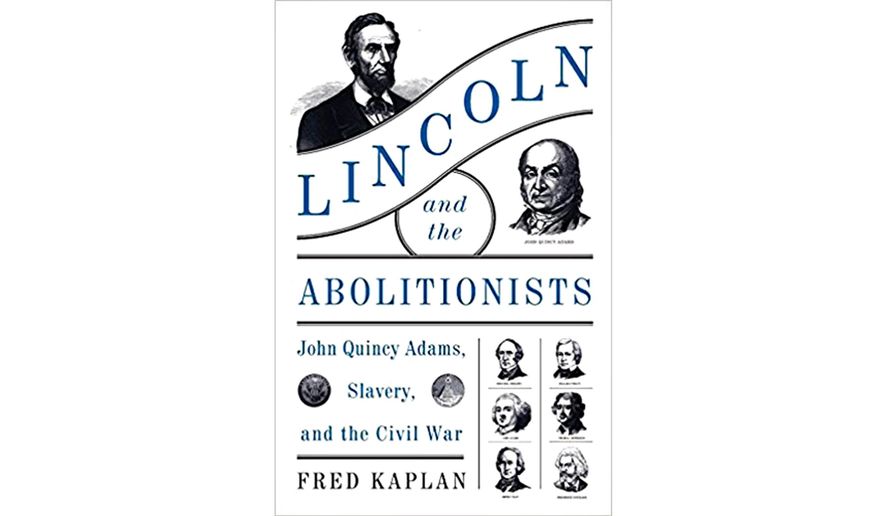OPINION:
LINCOLN AND THE ABOLITIONISTS: JOHN QUINCY ADAMS, SLAVERY, AND THE CIVIL WAR
By Fred Kaplan
Harper, $28.99, 366 pages
Myths die hard. None have resisted truth more than the fables that sprang up after Abraham Lincoln’s death launched his hagiography as The Great Emancipator of the roughly four million African-Americans held as chattel slaves.
History professor Fed Kaplan attempts to untangle the myths that blur a clear vision of America’s racial divide. It is a divide that came with the architecture of our national founding in 1786 and which muddy our attempts to heal that apparently worsening fracture in 2017. Mr. Kaplan has produced other biographies of Lincoln and John Quincy Adams, among others, and in this book he brings the two together as examples of men who abhorred the institution of slavery while shrinking from the prospect of the multi-racial society evolving around us today.
Mr. Kaplan’s conclusion, simply stated, is that both Lincoln and Adams were like many opinion leaders of the day viewed slavery as a danger to preserving the still aborning American Union while not being particularly sympathetic to the individual plight of the bondsmen in their midst. Yet even that grudging disapproval of slavery was itself a complicated political opinion to hold during the early decades of the 19th century.
That is the other point worth noting about this clearly written book. One cannot revisit the decades leading up to the Civil War without finding parallels with today’s political dysfunction with its violence-prone, gridlocked upheavals that have our two-party system swamped by rival waves of narrow-issue demagogues.
Mr. Kaplan begins his examination in 1837 when Lincoln, a freshly-minted lawyer and member of the Illinois legislature introduces a bill that condemns slavery. Lincoln was what was called a “free-soil” Whig, one of the two main parties, and one that firmly opposed both slavery and abolition.
As Mr. Kaplan explains, Whigs, “believed that the Constitution allowed the national government to control slavery, presumably with the consent of its residents, only in the District of Columbia. Otherwise, wherever it already existed it was untouchable. It could be deplored but not altered.”
That same year John Quincy Adams was plaguing the pro-slavery delegates in the U.S. House of Representatives with a series of unsuccessful procedural moves to override the firm ban on even discussing slavery, let alone blocking its expansion into the newly admitted states of the Middle West. Adams, too, was a Whig, after having been something called a National Republican as president in the 1820s, and then an Anti-Mason before joining the loose and often fractious Whig Party. Like Lincoln, he too avoided the radical and unforgiving Abolitionists of his home state of Massachusetts.
Mainly he, like Lincoln, was a firm Unionist. Only a strong and united people could hold and prosperously govern the vast continent spread before them like a banquet table for the taking. Slavery and the divisive passions it ignited was a threat to that Union. Better that economic consequences of a broad national expansion erode the financial support that slavery brought than to cause a national fracture which outright abolition would produce.
Slavery was a dominating issue during these decades and Mr. Kaplan acknowledges that freely. But it was important in large part for its impact on other issues. Texas had just seceded from Mexico and slave-owning expansionists eyed, and other newly settled territories with greedy eyes. A war with Mexico was impending and that too would test national resolve. Waves of exotic immigrants — from Germany, and more disturbing from Ireland — fueled anti-immigrant passions. Dismantling the legacy of the Trumpian Andrew Jackson proved vexatious.
Adams was still several years away from his legendary defense before the U.S. Supreme Court of the slaves who had escaped on the Amistad, a defense that has made him a Hollywood icon. But again, that praiseworthy defense was more grounded on a dispute over property rights than civil liberties. Still, from his seat in Congress he became ever more opposed to slavery and to the rush to expand U.S. territory westward for the stresses placed on national unity,
As for the slaves themselves, Lincoln would remain tantalized by a popular scheme of the day to rid America of its slaves through projects to colonize new nations in the Caribbean and Africa, starting with the roughly 400,000 free blacks who would be given incentives to seek their fortunes elsewhere, anywhere but here. Liberia and Sierra Leone would be established under U.S. protection, but during his own presidency Lincoln could not muster the support or resources to pursue a greater effort.
Mr. Kaplan has an interesting take on the Emancipation Proclamation that so defines what we think about Lincoln and race. In addition to calculating its strategic impact on the failing economy of the Confederacy, Mr. Kaplan also notes that the decree freeing bondsmen in the rebel territory explicitly did not affect those crucial states that had not joined the secession — Tennessee, Kentucky, and more closely at hand, Maryland and Delaware where a substantial population of slave owners also were pro-Union.
What we have is a complicated tale that, thanks to this book, can be more clearly understood, and its similarities with today’s imbroglio will fascinate the reader.
• James Srodes’ latest book is “Spies in Palestine” (Counterpoint, 2016).




Please read our comment policy before commenting.